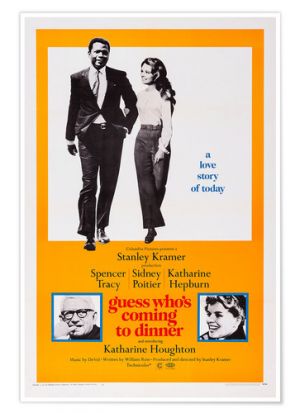Guess Who's Coming to Dinner (1967)
Guess Who’s Coming to Dinner was released on December 12, 1967, produced and directed by Stanley Kramer. The storyline was about a white liberal woman who engaged with a black doctor whom she met when in vacation in Hawaii and flew to her parent's home in San Francisco with her fiancé. The film was nominated for Best Picture, Director, Actor (Spencer Tracy), Supp. Actor (Cecil Kellaway), Supp. Actress (Beah Richards), Art Direction, Editing, Adapted Score. [1]
Contents
Plot
When Joanna “Joey” Drayton, a liberal raised educated white woman, came home from a period of vacation in Hawaii and brought her black fiancé, the high-qualified doctor, Dr. John Prentice to meet her parents in San Francisco. Her mother, Christina Drayton and father, Matt Drayton are wealthy liberals and must face the interracial relationships of their daughter of different races of marriage. This became a true test of their long-time beliefs : do they approve of their daughter marrying a black man. [2] Joey also invites John’s parents to the dinner, Mr and Mrs. Prentice without knowing that Joey is white, which later they strongly disapprove with their son’s relationship. Another person that was being invited to the dinner was a friend of her family, the liberal Monsignor Ryan. Through day and night, the families discusses the problem of their daughter and son. [3]
Pros
Guess Who’s Coming to Dinner was become one of the films that depict an interracial marriage in a positive way, as historically the practice had been illegal in most states of the United States and still illegal in 17 states, mostly Southern States, until six months before the film was released, Jun 12, 1967. [4]
Guess Who’s Coming to Dinner was an illustration of the impact of the verdict in Loving v. Virginia (1967). A case where a black woman and a white woman have been sweet hearted since childhood. Only 6 months before the release of the film, the verdict removed laws which banning interracial marriages in the United States under the Fourteenth Amendment. Prior to this judgment, anti-miscegenation laws still exist mostly in the South and applied in sixteen states. Justice Earl Warren’s judgement ended laws ‘which prohibit[ed] and punish[ed] marriages on the basis of racial classifications.’ However, a legal ruling does not instantly change public opinion about interracial marriage until a year after the Loving v. Virginia verdict and the release of the film, only 20% of Americans approve of mix-racial marriage, between blacks and whites in 1968. [5]
Controversy
In the movie, Joey’s parents who are socially liberal and pride themselves on their unbiased perspective about race and class, deep down, they express objections after knowing her daughter is engaged with a high quality African-American man. Her parents claim they object to the union, worrying that she will face discrimination if seen with a black man. [6]
The presence of Prentice’s parents also leads to troublesome, as they are opposed the interracial marriage. Surprisingly, this leads Prentice attacked his father back, lectured and accused him of being Uncle Tom: "Your generation will always think of itself as Negro first and a man second. I think of myself as a man." [7]
With its radical interracial romance, the film, marked the first where a white actress and a black actor kissed in a big scene. Consequently, some theaters in the South refused to show it. “Columbia Pictures, when they found out what the film was about, they didn’t want to do it. And they did everything they could to stop filming,” recalls Houghton. “They kept saying, ‘Nobody’s going to ever come and see this film. We’re going to lose millions of dollars on this film.’" [8]
Back in 2003, Houghton was never to bee seen in so successful movie, well knew what the film had achieved: “Anybody who’s ever been involved in an interracial marriage of any sort, or even a gay relationship, any kind of relationship that’s not approved of, that movie became a metaphor for those kinds of situations,” she told.
“I don’t think it did a thing for civil rights. ... It was a movie for white people,” she added. [9]
References
- ↑ https://variety.com/1967/film/reviews/guess-who-s-coming-to-dinner-1200421442/
- ↑ https://variety.com/1967/film/reviews/guess-who-s-coming-to-dinner-1200421442/
- ↑ https://www.imdb.com/title/tt0061735/plotsummary?ref_=tt_stry_pl
- ↑ https://en.wikipedia.org/wiki/Guess_Who%27s_Coming_to_Dinner#:~:text=Guess%20Who's%20Coming%20to%20Dinner%20is%20a%201967%20American%20comedy,features%20Hepburn's%20niece%20Katharine%20Houghton
- ↑ http://www.midlandshistoricalreview.com/guess-whos-coming-to-dinner-and-hollywoods-misrepresentation-of-the-politics-of-interracial-relationships-in-1960s-america/
- ↑ https://thehill.com/opinion/civil-rights/433896-guess-whos-coming-to-dinner-the-private-shame-of-racial-disloyalty
- ↑ https://www.rogerebert.com/reviews/guess-whos-coming-to-dinner-1968
- ↑ https://apnews.com/article/b198d2db3ba148a4a9036333cd74cefd#:~:text=Houghton%20and%20co%2Dstar%20Sidney,seemed%20suspicious%20to%20the%20actors.
- ↑ https://www.chicagotribune.com/entertainment/theater/ct-ae-guess-who-dinner-jones-0401-story.html

